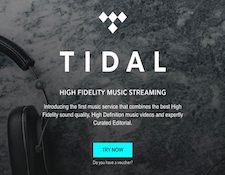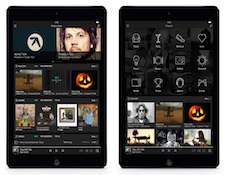It’s the time of year for saving money!
After several weeks of anticipation I had an opportunity to audition the new LOSSLESS streaming site TIDAL. While nothing is perfect, the new Tidal site does have more full-frequency uncompressed music than any other site, which certainly gives TIDAL a sonic leg up over Spotify, Pandora, and i-Tunes Match.
 In my current system, which consists of a new MacPro “titanium trashcan” desktop computer with 16 GB memory, 256 SS drive, and 5 TB external raid external drive, Oppo HA-1 USB DAC/Pre, assorted headphones, a pair of Bel Canto M-300 monoblock amps and Audience 1+1 speakers I spent over an hour going back and forth between my iTunes player and TIDAL player with identical (at least in length and bit-rate) tracks. I couldn’t reliably tell any sonic differences between the two once their levels were matched.
In my current system, which consists of a new MacPro “titanium trashcan” desktop computer with 16 GB memory, 256 SS drive, and 5 TB external raid external drive, Oppo HA-1 USB DAC/Pre, assorted headphones, a pair of Bel Canto M-300 monoblock amps and Audience 1+1 speakers I spent over an hour going back and forth between my iTunes player and TIDAL player with identical (at least in length and bit-rate) tracks. I couldn’t reliably tell any sonic differences between the two once their levels were matched.
As far as sound quality goes, I’m onboard with TIDAL. And while I’m not sure that TIDAL will be more important to the advancement of audio quality than DSD 2x or 192/24 high-resolution files, it will give music lovers an opportunity to get closer to the original recording than any MP3 streaming source.
But sound quality isn’t everything – if the interface isn’t up to snuff potential users won’t hang around long enough to enjoy the music. At first I wasn’t too thrilled with TIDAL’s interface. My primary genres, Acoustic, Roots, and Americana are not represented in the Genre choices that greet new TIDAL users. When I saw the list of Genres – Pop, Rock, Indie/Alternative, Metal, Hip-Hop/Rap, R&B Soul, Country, Blues, Jazz, Classical, Electronic, Dance, Kids, World, Latino, Reggae, Christina and Gospel, Comedy, Soundtracks, and Retro, I was concerned that the kind of music I favor, which is primarily from small labels and independent artists would not be found on TIDAL, and within the Genre categories I was right – it was populated by mainstream popular artists. But all was not lost, when I began to use TIDAL’s search function I discovered that TIDAL did have tracks from some of my faves, but in many cases the tracks were from other artist’s albums that they played on. Dominick Leslie, for instance, was located on an album by Alasdair Fraser, but none of The Deadly Gentlemen’s tracks, which is his main band, showed up until I searched specifically for “The Deadly Gentlemen.”
 If your primary use for streaming services is to discover new music, which used to be FM radio’s main function for many listeners, TIDAL gets an “average” rating. On the computer app it suggests other “related” artists when you select a track, but the suggestions are only so-so. For The Deadly Gentlemen TIDAL came up with Nickel Creek. Close, sort of, but no cigar. If TIDAL had come up with Crooked Still and Brittany Haas I would have been more impressed.
If your primary use for streaming services is to discover new music, which used to be FM radio’s main function for many listeners, TIDAL gets an “average” rating. On the computer app it suggests other “related” artists when you select a track, but the suggestions are only so-so. For The Deadly Gentlemen TIDAL came up with Nickel Creek. Close, sort of, but no cigar. If TIDAL had come up with Crooked Still and Brittany Haas I would have been more impressed.
I also loaded the TIDAL app onto my iPhone. The iPhone app may be better for new TIDAL users than the computer app in that it has an introduction that leads you through the app’s functions. Listening through a pair of Blue Mike’s Mo-Fi headphones I was impressed by the detail and image specificity I heard listening to The Deadly Gentlemen’s “Working” from their first album.
For anyone who spends a lot of time out and about TIDAL is a giant step up in mobile sound quality. For $20 a month being able to listen to full-resolution lossless files without having to carry around an extra hard drive or fill up your smartphone’s storage is a big step forward. It’s a step that I hope many music lovers and audiophiles will make, because once they do I doubt that they, or you, will be happy with compressed MP3 ever again. And PONO? I think TIDAL just ate your lunch.





